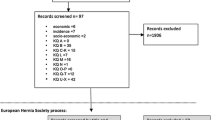Summary
Objective
To analyze the benefit and feasibility of single-incisional laparoscopic totally extraperitoneal (SIL TEP) repair compared with those of conventional laparoscopic TEP (CL TEP).
Methods
The procedure of laparoscopic herniorrhaphy includes medial, lateral, and sac dissection with mesh positioning. The actual procedure performed during SIL TEP is the same as those of CL TEP, except for the number of incisions. We performed SIL TEP in 23 patients with an inguinal hernia. The operative and short-term outcomes, including postoperative complications and recurrence, were analyzed and compared with 140 cases of CL TEP.
Results
Age, gender, BMI, comorbidity, ASA score, and types of hernia were similar in both groups. Also, operation time, open or transabdominal preperitoneal conversion rate, length of hospital stay, postoperative complication rate, and recurrence were not significantly different between the two groups.
Conclusion
SIL TEP is as feasible and safe a procedure as laparoscopic herniorrhaphy. Surgeons familiar with single-incision laparoscopic surgeries like appendectomy or cholecystectomy can begin to perform SIL TEP for hernia repair.


Similar content being viewed by others
Abbreviations
- ASA:
-
American Society of Anesthesiologists
- ASIS:
-
Anterior superior iliac spine
- BMI:
-
Body mass index
- CL:
-
Conventional laparoscopic
- MIS:
-
Minimally invasive surgery
- SIL:
-
Single-incision laparoscopic
- TAPP:
-
Transabdominal preperitoneal
- TEP:
-
Totally extraperitoneal
References
Yang GP, Tung KL. A comparative study of single incision versus conventional laparoscopic inguinal hernia repair. Hernia. 2015;19(3):401–5.
Wijerathne S, Agarwal N, Ramzy A, Lomanto D. A prospective randomized controlled trial to compare single-port endo-laparoscopic surgery versus conventional TEP inguinal hernia repair. Surg Endosc. 2014;28(11):3053–8.
Perivoliotis K, Tzovaras G, Sarakatsianou C, Baloyiannis I. Current status of single-port versus multi-port approach in laparoscopic inguinal hernia mesh repair: an up-to-date systematic review and meta-analysis. Hernia. 2019;23(2):217–33.
Lomnicki J, Leszko A, Kulis D, Szura M. Current treatment of the inguinal hernia—the role of the totally extraperitoneal (TEP) hernia repair. Folia Med Cracov. 2018;58(3):103–14.
Chung Y, Choi JW, Kim HC, Kim SH, Choi SI. Feasibility of totally extraperitoneal (TEP) laparoscopic hernia repair in elderly patients. Hernia. 2019;23(2):299–303.
Han YD, Park S, Kim WR, Baek SJ, Hur H, Min BS, et al. Safety and efficacy of single-incision laparoscopic totally extraperitoneal inguinal hernia repair: comparative study with conventional laparoscopic totally extraperitoneal inguinal hernia repair. J Laparoendosc Adv Surg Tech A. 2017;27(3):253–8.
Kim JH, An CH, Lee YS, Kim HY, Lee JI. Single incision laparoscopic totally extraperitoneal hernioplasty (SIL-TEP): experience of 512 procedures. Hernia. 2015;19(3):417–22.
Lai H, Li G, Xiao J, Lin Y, Lu B. Single-incision laparoscopic hernioplasty versus multi-incision laparoscopic hernioplasty: a meta-analysis. ANZ J Surg. 2014;84(3):128–36.
Wakasugi M, Masuzawa T, Tei M, Omori T, Ueshima S, Tori M, et al. Single-incision totally extraperitoneal inguinal hernia repair: our initial 100 cases and comparison with conventional three-port laparoscopic totally extraperitoneal inguinal hernia repair. Surg Today. 2015;45(5):606–10.
Wijerathne S, Agarwal N, Ramzi A, Liem DH, Tan WB, Lomanto D. Single-port versus conventional laparoscopic total extra-peritoneal inguinal hernia repair: a prospective, randomized, controlled clinical trial. Surg Endosc. 2016;30(4):1356–63.
Choi BJ, Jeong WJ, Lee IK, Lee SC. Single-port versus conventional three-port laparoscopic totally extraperitoneal inguinal hernia repair: a randomized controlled trial. Hernia. 2016;20(6):789–95.
Choi YY, Kim Z, Hur KY. Learning curve for laparoscopic totally extraperitoneal repair of inguinal hernia. Can J Surg. 2012;55(1):33–6.
Wakasugi M, Nakahara Y, Hirota M, Matsumoto T, Kusu T, Takemoto H, et al. Learning curve for single-incision laparoscopic totally extraperitoneal inguinal hernia repair. Asian J Endosc Surg. 2019;12(3):301–5.
Suguita FY, Essu FF, Oliveira LT, Iuamoto LR, Kato JM, Torsani MB, et al. Learning curve takes 65 repetitions of totally extraperitoneal laparoscopy on inguinal hernias for reduction of operating time and complications. Surg Endosc. 2017;31(10):3939–45.
Kang BM, Hwang JW, Ryu BY. Single-port laparoscopic surgery in acute appendicitis: retrospective comparative analysis for 618 patients. Surg Endosc. 2016;30(11):4968–75.
Kang BM, Choi SI, Kim BS, Lee SH. Single-port laparoscopic surgery in uncomplicated acute appendicitis: a randomized controlled trial. Surg Endosc. 2018;32(7):3131–7.
Arezzo A, Passera R, Forcignano E, Rapetti L, Cirocchi R, Morino M. Single-incision laparoscopic cholecystectomy is responsible for increased adverse events: results of a meta-analysis of randomized controlled trials. Surg Endosc. 2018;32(9):3739–53.
Vierra M. Minimally invasive surgery. Annu Rev Med. 1995;46:147–58.
Lee JW, Sung SW, Park JK, Park CH, Song KY. Laparoscopic gastric tube formation with pyloromyotomy for reconstruction in patients with esophageal cancer. Ann Surg Treat Res. 2015;89(3):117–23.
Author information
Authors and Affiliations
Corresponding author
Ethics declarations
Conflict of interest
J.W. Lee, E.Y. Kim, A. Bat-Ulzii, A.R. Sharma, and H.S. Kim declare that they have no competing interests.
Ethical standards
All procedures performed in studies involving human participants or on human tissue were in accordance with the ethical standards of the institutional review board of Chuncheon Sacred Heart Hospital. Informed consent was obtained from all individual participants included in the study.
Additional information
Publisher’s Note
Springer Nature remains neutral with regard to jurisdictional claims in published maps and institutional affiliations.
Availability of data and materials
The material supporting the conclusion of this study has been included in the manuscript.
Rights and permissions
About this article
Cite this article
Lee, J.W., Kim, E.Y., Bat-Ulzii, A. et al. Safety and feasibility of single-incision laparoscopic totally extraperitoneal inguinal hernia repair: a retrospective comparative analysis of 163 patients. Eur Surg 53, 294–298 (2021). https://doi.org/10.1007/s10353-020-00646-z
Received:
Accepted:
Published:
Issue Date:
DOI: https://doi.org/10.1007/s10353-020-00646-z




